August 2013 Archives
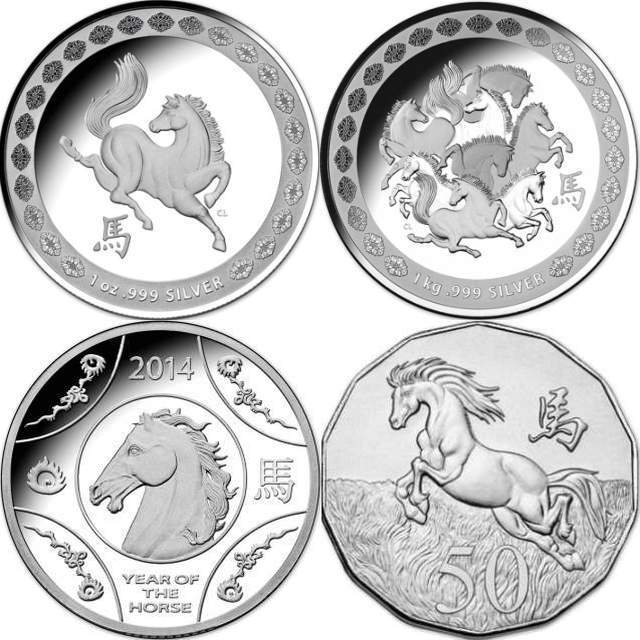
Australia 2014 Lunar Year of the Horse Coins (image courtesy www.ramint.gov.au)
If you're a horsey person then 2014 is your year! The Chinese Zodiac rotates 12 animals and for 2014 it's the Lunar Year of the Horse. As such various Mint's around the world strike special coins to commemorate this or celebrate the birth of a little one born under the chinese sign of the horse. The Australian Mint's both the Perth Mint and the Royal Australian Mint take the opportunity to mint coins in fine silver and gold, many as bullion products. Australia's circulating coin producer the Royal Australian Mint will, on September 2nd release their 2014 offering with 4 different designs.
Above top left is the RAM's 1 ounce fine silver proof-like 1 dollar offering with the "Kicking Horse" design, this coin with a mintage of 10,000 coins. The design is by Chrissy Lau, an artist and illustrator based in Sydney. It will also be minted in 5 ounces of proof-like fine silver with a $10 legal tender value. If you like Chrissy's design and prefer it in gold and you have deep pockets then the $100 1 ounce proof-like gold coin will set you back $2,275 with a mintage limit of 1,500 coins. In the special made to order program a $500 gold proof will also be available with this design.
Above top right you see the largest coins in the RAM's Prestige Lunar Series a whole kilogram of fine silver coin with a $30 legal tender value. This design of Eight Horses is also by Chrissy Lau. Struck in proof-like fine silver this huge 99.95 millimetre coin will have a maximum mintage of 1,500 coins. Again in the made to order program is a $3,000 face value gold proof coin, you'll have to contact the RAM sales team for more information if you are interested in that one.
Above bottom left is the fine silver proof (mintage 10,000) version of the (seen below) aluminium bronze 25 millimetre one dollar coin. This al br 9 gram coin is the same as a $1 coin found in change but is not issued for circulation, as with all these coins they are NCLT or non-circulating legal tender. The aluminium bronze dollar retails for $13.50 and the fine silver boxed proof $55.
Above bottom right is the tetradecagon 50 cent, a coin with 14 sides instead of the usual 10 for our fifty cent. It's struck in cupro-nickel, the design featuring the chinese character for horse in the sky above an unbridled horse cavorting in fields of grass. The copper-nickel 50 cent has an unlimited mintage and is released in a collector card and a presentation box at $12.50 each.
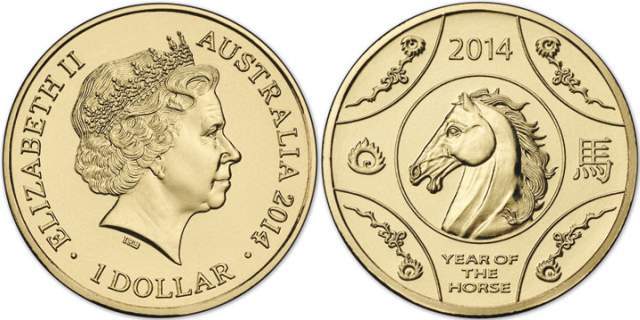
Australia 2014 Lunar Year of the Horse Aluminium Bronze 1 Dollar (image courtesy www.ramint.gov.au)
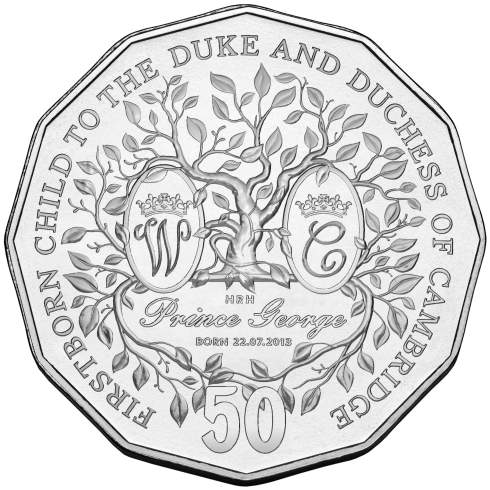
Australia 2013 Royal Baby 50 Cent (image courtesy www.ramint.gov.au)
The birth of baby Prince George, the firstborn child, a son for Prince William and Princess Catherine the Duke and Duchess of Cambridge is being celebrated with a special 50c released by the Royal Australian Mint.
This Australian commemorative 50 cent, dodecagonal in shape is being released in copper-nickel uncirculated and stunning silver proof, the proof coin with a limited mintage of just 10,000 coins. The reverse design depicts the latest branch in the Royal family tree with the W and C initials for William and Catherine and HRH Prince George Born 22.7.2013. Prince George Alexander Louis or Prince George of Cambridge is third in line to the throne after his father William and grandfather Charles. The Royal Baby is the Queen's first great grandchild.
The design is by the Royal Australian Mint in consultation with Buckingham Palace and is a fitting addition to the many Royal Baby coins we're now seeing. Coins already struck include Royal Baby commemoratives by The Perth Mint, The Royal Mint in the UK, and the Royal Canadian Mint. We'll surely see more special baby coins as the Royal Christening approaches.
Pick up a new Royal Baby coin from the Royal Australian Mint or your friendly local coin dealer. The cupro-nickel coin retailing at $9 and the silver proof issued at $80.
Melbourne is to host the International Coin and Banknote Show at Etihad Stadium on the 18, 19 and 20th October 2013. It will be open from 10am each day closing at 6pm on Friday and 5pm on Saturday and Sunday. This coin show WILL be bigger than the ANDA coin shows seen in various capital cities throughout the year. It is being touted as THE largest coin show in Australia in the past 10-20 years and the numismatic event of the decade. This mega-event will include viewing and the IAG (International Auction Galleries) Auction sale number 78 usually held on the Gold Coast. Highlights of this auction include a Holey Dollar and three Adelaide pounds. This auction will be held next door to the show on the Saturday night.
This International Coin Show will be the place to meet coin designers, buy special show release coins and attend seminar presentations by numsimatic experts (hopefully not the ones currently in receivership ). The Royal Australian Mint will be in attendance with their mobile coin press to strike an M counterstamp onto a Holey Dollar and Dump Bicentenary 2013 1 Dollar coin -a usual favourite missed at the Melbourne ANDA coin show held in July this year. The Perth Mint will also have their show product a 2013 lenticular 1 oz silver proof dollar celebrating Melbourne and St Petersburg sister cities. Struck in 99.9% pure silver this issue will be limited to only 2,000 coins.
2013 is a memorable year in numismatics with celebrations for 200 years since Australia struck it's first coins the holey dollar and dump and 100 years of Commonwealth Banknotes. It's also the first time we've seen a coloured coin in circulation the purple striped Coronation $2 celebrating the Queen's 60 years since being crowned monarch.
The Etihad venue is fully air conditioned and just a short walk from Spencer St Station adjacent to the stadium via a walkway. There is also ample car parking if you choose to drive. A cafe with with snacks, lunch and beverages will keep you going as you take a breather from the vast dealer tables and counterstamp queue to catchup with numismatic acquaintances.
There will be displays by the Melbourne Museum and the Royal Australian Mint and keep your eye open for a special showbag! Dealers attending include:
Australia Post
Australian Coin Auctions
Bullion List Pty Ltd
Classy Collectables
Coin Invest Trust
Coinsearch
Collectors Universe (Hong Kong) Ltd (PCGS)
Colonial Coins & Banknotes
Downies
Downies Australian Coin Auctions
Drake Sterling Numismatics
Eccles Coins & Banknotes
Euro-Yu Oz Pty Ltd
Global Coins & Banknotes Pty Ltd
Gold Stackers Australia Pty Ltd
International Auction Galleries
Klaus Ford Numismatics
Macquarie Mint
Monetarium Australia
Pacific Rim Coins
Peter Strich Stamps and Coins
Prospect Coins
The Royal Australian Mint (with the Portable Press)
Royal Mail
Salamanca Rare Coins
Sterling & Currency Pty Ltd
The Perth Mint
The Royal Australian Mint
The Royal Mint
Tony James Noteworld
Universal Coin Co
VP Coins
Waterman's Coins & Banknotes
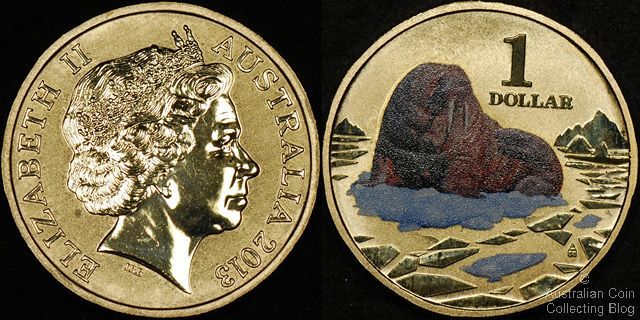
Australia 2013 Walrus Coloured 1 Dollar
The Walrus is another coloured dollar coin in the Royal Australian Mint's 6 coin Polar Animals series. It was issued in the second release of 2 coins in May 2013.
Close your eyes and picture a Walrus - what do you see? A big, bulky animal with tusks, lying around on the ice all day, lots of noise, fighting and jostling. Anything else comes to mind?
Nothing? OK, let's give you some more information.
You might be interested to know that the plural of walrus is walruses.
Both male AND female walrus have downward-pointing tusks, made of ivory. The tusks can grow up to 1 metre in length and are used to smash through the ice to gain access to the sea and for hauling themselves out of the water or across the ice (referred to as "tooth walking"). The tusks also provide a fulcrum for breathing. The walrus hangs vertically from a hole in the ice, with it's snout just above the water line, positioning it's tusks across the ice to take it's body weight.
As their tusks have growth rings, they can be aged using the same method for aging trees.
The tusk also distinguishes rank - the longer the tusk, the more prominent and important the walrus is in it's community.
The walrus can turn it's flippers forward, allowing it to move easily across the ice. Each flipper has 5 digits.
The Walrus doesn't have ears.
When they need to feed, they dive to great depths to the ocean bed - using their tusks to rake through the ocean bed sediment and then using their whiskers to locate clams, mussels, snails, crabs, shrimp, worms and other ocean floor organisms. They also blow to move the shellfish out of the sediment. When there's a lack of shellfish, Walrus have been known to feed on young seal carcasses.
Walruses have a very low reproductive rate with females giving birth to 1 calf almost every two years. The gestation period is from 15 to 16 months, with calves weighing up to 75kg at birth. Calves are weaned from their mothers after a year, and will spend up to 5 years with their mothers.
The Killer Whale and Polar Bear (depicted on another coin in this series) are the Walruses natural predators. Man too has played a huge part in being a significant threat in taking this species to the edge of extinction, through commercial hunting for their tusks, oil, skin and meat. Thankfully commercial hunting is now banned, with only Native Americans being allowed to "culturally" hunt, allowing the Walrus population to recover their numbers.
Global warming, is also playing it's part in threatening the Walrus. As the earth becomes warmer, the ice pack is reducing in size. Smaller ice packs means Walruses can't live near their optimal feeding grounds. Calves are then left on their own for longer and longer periods, suffering nutritional stress. As Walrus communities are spending less time with one another because of the distances traveled to feed, lower reproductive rates are being recorded. Smaller ice packs also means there's less real estate to haul out onto - stampeding deaths from overcrowding have been reported.
The Walrus coin is a standard 9 gram 25 millimetre one dollar coin. The reverse frosted uncirculated finish is a Walrus design by Aaron Baggio, with the obverse portrait of Queen Elizabeth II by Ian Rank-Broadley. This coin is one of six coins in this series -others depict the Polar Bear, Rockhopper Penguin, Atlantic Puffin, Weddell Seal and the Humpback Whale. The Polar Animals series follows the successful Animals of the Zoo Series of 2012 and the Air, Land and Ocean series of previous years.
The Walrus coin is issued at $15 and is presented in a colourful collector's card. Mintage is unlimited at this time and will be determined by collector demand. See the 2013 1 dollar coin mintages table for the most up to date mintage information.
I confess I joined Twitter today simply to try to bring the Coronation coin swap to my capital city. I had so far resisted the urge to become a tweeter. In saying that I have no idea what I'm doing, a Twitter newbie (and yes I googled). The Royal Australian Mint has a competition running until the 26th August to vote for the capital city you'd like the next coin swap to be held in. The coin swap will be the Coronation $2 coin, yes the purple striped coin you can find in your change. To be sure to get your hands on one of these the coin swap event will allow you to swap a regular $2 from your pocket for a new shiny purple 2 dollar coin commemorating the 60th Anniversary of the Coronation of Queen Elizabeth II. To vote, tweet your capital city or the capital city you'd like to see the coin swap held @RoyalAustMint
Brisbane - #CoinSwapBrisbane
Sydney - #CoinSwapSydney
Canberra - #CoinSwapCanberra
Melbourne - #CoinSwapMelbourne
Hobart - #CoinSwapHobart
Adelaide - #CoinSwapAdelaide
Perth - #CoinSwapPerth
Darwin - #CoinSwapDarwin
Coin swap events have proved very successful with swaps held at Circular Quay in Sydney during the Royal Wedding of William and Kate in 2011 for their special commemorative 20 cent coin. This year an event held on the Mint's own doorstep at One Very Big Day a celebration of the Centenary of Canberra saw a crowd of Canberrans swap everyday 20 cent coins for a lustrous new Canberra Centenary 20c.
So head on over to Twitter and if you're not sure of what city to vote for then the Blog team would happily see this event held in Adelaide!! The winning city with the most votes will be announced on Monday September 2nd after which the exact location within that city and date will be announced!
Update 26/8/13: Aaaaaaand the winner is Brisbane! More information announced shortly.
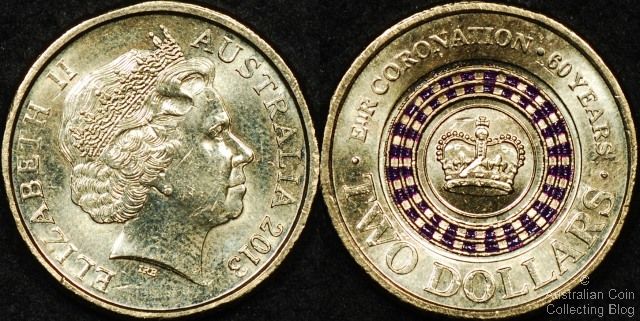
Australia 2013 Purple Coloured Coronation Circulating 2 Dollar Coin
The coloured Animals of the Zoo series was released in 2012 and comprises of 6 Australian legal tender 1 dollar coins in pad printed colour. The series commemorating the 150th birthday of the Melbourne Zoo. The Royal Melbourne Zoological Gardens as it is correctly named is located in Parkville just 4 kilometres from the city centre and is Australia's oldest Zoo opened in 1862 and modelled on the London Zoo. It exhibits over 300 species of animals and attracted almost 1.2 million visitors in it's 150th year. The Melbourne Zoo is the matriarch of a family of 3 Victorian Zoos which include Werribee Open Range Zoo and the Healesville Sanctuary
Each $1 coin is released in a colourful collector card by Australia's circulating coin producer the Royal Australian Mint but these coins are not intended to circulate. They are however issued for the collector market as NCLT (non-circulating legal tender) and appeal not just to coin collectors but animal enthusiasts and kids. Each coin has the standard specifications of a circulating one dollar - weight 9 grams, diameter 25 millimetres, composition aluminium bronze and have interrupted edge milling. Each coin features the obverse of Queen Elizabeth II by Ian Rank-Broadley.
The Gorilla, Elephant, Southern Corroboree Frog, Sumatran Tiger, Goodfellow's Tree-Kangaroo and Orang-utan coins all depict a pad printed colour reverse with a frosted uncirculated finish. Much more care is taken in the production process for a collector coin like this than a coin you will find in circulation. There is in fact a design struck onto the coin and the colour overlaid in a second process. Each reverse coin design was sculpted by Mint designer Aaron Baggio.
The Sumatran Tiger dollar can also be found in a PNC (philatelic numismatic cover) issued by Australia Post for $15.95. Each coloured dollar card was issued for $15. There are many many Australian dollar coins to collect both in your change and collector coins.
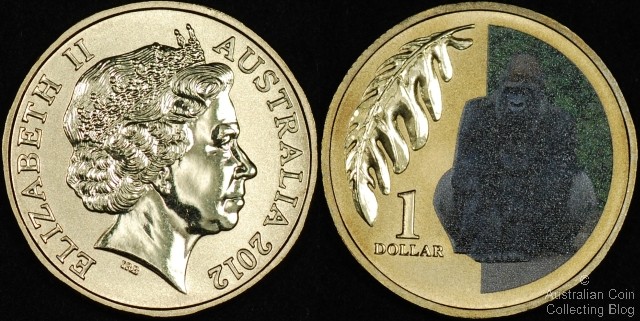
2012 Coloured Western Lowland Gorilla $1
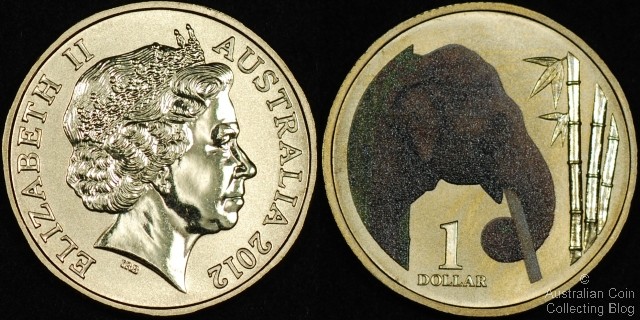
2012 Coloured Asian Elephant $1
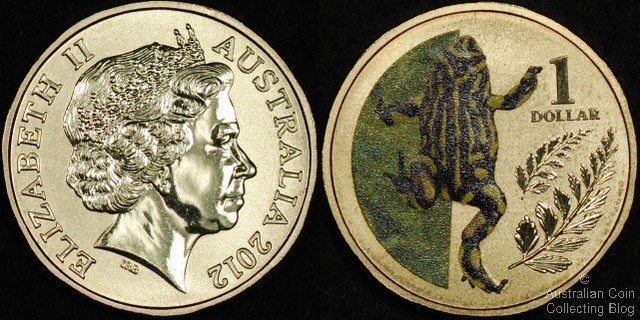
2012 Coloured Southern Corroboree Frog $1
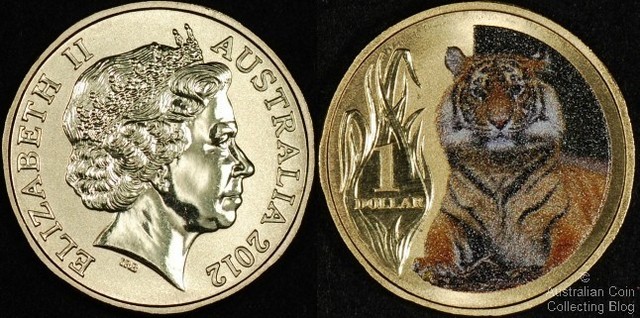
2012 Coloured Sumatran Tiger $1
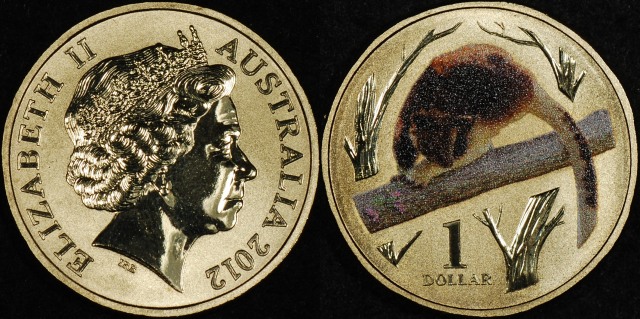
2012 Goodfellow's Tree-Kangaroo $1
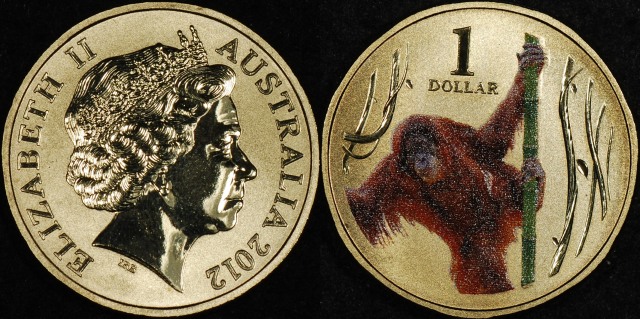
2012 Sumatran Orang-utan $1
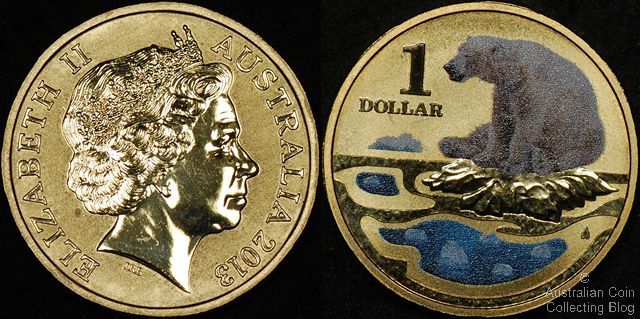
Australia 2013 Polar Bear Coloured 1 Dollar
The first coloured dollar coin released in the Royal Australian Mint's Polar Animals series is the Polar Bear coin.
The majority of people will never have the opportunity to visit the Arctic Circle surrounding the North Pole to witness these magnificent animals in their natural habitat. Which is probably just as well - besides being cold and not very hospitable, I can't imagine being up close and personal to such a huge, heavy (anywhere from 340 to 544 kilograms), carnivorous animal - you've only to picture the fearsome Polar Bear character, Lorek Byrnison, from the movie Golden Compass and you'll probably agree.
Sadly, the most disturbing common thread amongst all the animals portrayed in this coin series is that populations and habitats are being threatened as a result of human intervention - the two biggest culprits being hunting and global warming. As the ice caps melt, it's harder and harder for the bears to find food, with the search for food bringing the Polar Bears into close contact with the sparse human populations that also call the Arctic Circle home. Which in turn leads to conflict - the Polar Bear more often than not being the loser.
However, there's hope for the Polar Bear population. Like most other threatened species, their numbers may be revived because of "breeding in captivity" programs in zoo's and animal sanctuaries around the world. While it's a controversial option, with exorbitant costs incurred to simulate animal habitats, "breeding in captivity" programs do allow threatened species to become more accessible to the general public, as well as these programs serving as an educational tool to enlighten us about their plight.
Which is why, after 13 years of hard work, Sea World Gold Coast Australia can be very proud to welcome it's first polar bear cub borne in captivity in May 2013. And that's a big accomplishment indeed, as the newborn is only the second ever polar bear cub to borne in Australia, the first being born in South Australia in 1985.
There's such interest by the general public that Sea World has installed 6 cameras and multiple TV monitors adjacent to the Polar Bear den affectionately called "Cub Kindy". The cub's daily activities and the magical relationship developing between mom "Liya" and her cub are being closely monitored. Plans are underway to present the pair to the general public in September 2013. It's also anticipated that the cub's name and sex will be revealed at the same time.
This coin is the first of six NCLT (non-circulating legal tender) one dollar coins in this series. Other coins in the Polar Series are the Weddell Seal dollar, Rockhopper Penguin dollar, Walrus dollar and the Humpback Whale dollar. These 1 dollar coins are 25 millimetres in diameter, weigh 9 grams and are struck on an aluminium bronze planchet. This reverse design depicting the Polar Bear has been designed by Aaron Baggio and is presented in pad-printed colour with a frosted uncirculated finish. The obverse depicts the Ian Rank-Broadley effigy of Queen Elizabeth II.
The Polar Bear coin retails at $15 and is presented in a colourful collector's card. Mintage is unlimited at this time and will be determined by collector demand. See the 2013 1 dollar coin mintages table for the most up to date information.


